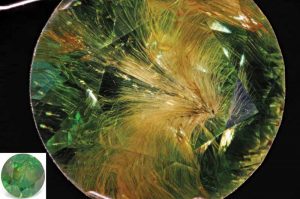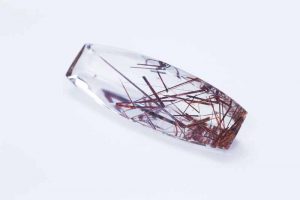By Lauriane Lognay

Photos courtesy Rippana Inc.
Gemstones are more than simply part of the piece
of jewellery they’re set in. Each stone has an origin,
and with it an amazing story to tell.
What are inclusions?
Inclusions are present in almost every gemstone and take many shapes and forms.
There are three types: liquid, gas, and solid. Each forms at different times during the process of crystallization. They can be combined to form one, two, or three-phase inclusions. Liquid with gas, for example, would be a two-phase inclusion.
Inclusions are also the key to understanding the origin of a gemstone. They are the most important aspect in determining not only the formation of the gems, but also if it is natural or treated.
Why is the origin of a gemstone so important?
Proof of origin can be very important for pricing a gemstone. If you have a high-quality emerald and you don’t know how to determine the price, laboratories such as the Gemological Institute of America (GIA) or American Gemological Laboratories (AGL) will determine it by its origin. With emeralds, Colombia is the best origin. Zambia is also a good origin, however, their stones are not as valuable.
Paraiba tourmalines wouldn’t be Paraiba if it didn’t come from this location. It would be called cuprian tourmaline and wouldn’t have the same value.
According to the GemGuide, an independent pricing magazine for coloured gemstones and diamonds, if you have a one-carat good quality cuprian tourmaline from Paraiba, you could easily sell it for US$7000 per carat or more. However, if the same quality and size tourmaline is cuprian but not from Paraiba, the stone’s value decreases to US$2500 per carat.
Why are inclusions good for you and you client?

Many jewellers will have a client that’s said they don’t want a gemstone because it has inclusions and believe them to be a sign of ‘bad quality.’
While some inclusions are a sign of bad quality, most of the time it’s good to have a few, even if they’re too small to the naked eye.
It’s possible to determine the origin of the gemstone by its inclusions most of the time by analyzing a stone’s chemical composition and formation of the inclusion within the gem. For instance, horsetail inclusions in demantoid garnet are Russian, as we know this has always been the only place one could find this specific inclusion.
In order to gain a client’s trust, inclusions should be shown to them in a loupe or through a microscope. In doing so, should repairs or changes need to be made to the piece of jewellery, the client will be able to recognize the gems as their own. This protects you, as a jeweller, from incidents when a client says it’s not their stone.





